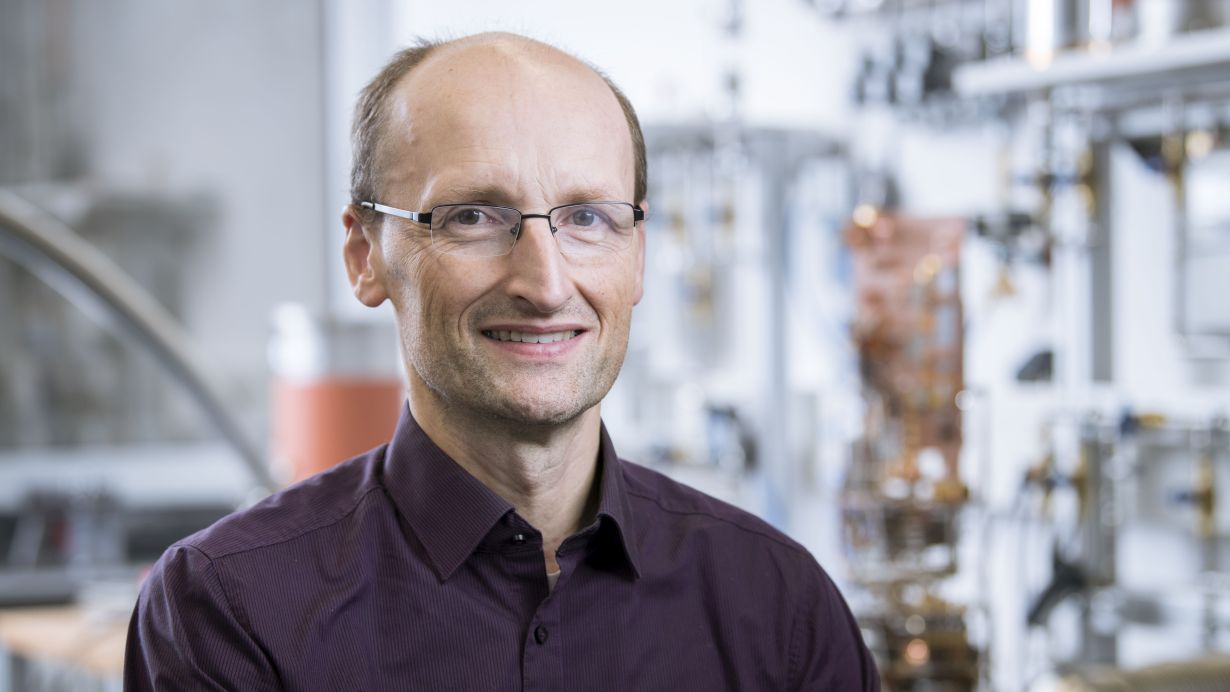
The European Research Council (ERC) has decided to fund the international project "Quantum Technologies for Axion Dark Matter Search", or short DarkQuantum, with an ERC Synergy Grant. Physicist Professor Wolfgang Wernsdorfer from Karlsruhe Institute of Technology (KIT) is involved in the project as lead researcher. DarkQuantum aims to experimentally prove the existence of axions with the help of quantum technology. These as-yet-hypothetical elementary particles are believed to be very promising dark matter candidates.
It permeates our universe and poses major challenges to research: Dark matter. As it does not emit any light nor any other kind of electromagnetic radiation, it remains invisible. Although dark matter is evident in many astrophysical and cosmological observations, its particle physics is still unclear. According to a convincing hypothesis, dark matter consists of very light axions which interact weakly with ordinary matter. They are as-yet-hypothetical elementary particles of low mass. Within a strong electromagnetic field, the hypothesis suggests, axions can convert into electromagnetic waves and vice versa. In theory, there is every indication for axions as dark matter candidates. However, their existence has yet to be proven by experiment.
Quantum-based Haloscopes Search for Axions
The European DarkQuantum project searches for axions and is aiming at proving their existence. Professor Wolfgang Wernsdorfer of KIT's Physikalisches Institut (PHI) is one of the lead researchers in the project, which is funded by the European Research Council with a Synergy Grant. "The nature of quantum phenomena is one of the great, unsolved and therefore particularly fascinating issues in research. I am delighted that Wolfgang Wernsdorfer and his colleagues in Germany and abroad have been able to jointly acquire one of the prestigious ERC Synergy Grants," says Professor Oliver Kraft, Acting President of KIT.
DarkQuantum uses quantum technology and combines it with particle physics infrastructures at CERN and at DESY in order to detect axions in the galactic halo, which is the exterior part of the Milky Way. Superconducting qubits enable the design of instruments that are extremely sensitive to tiny amounts of electromagnetic radiation, with much lower background noise than conventional technologies. The plan is to build two quantum-based haloscopes. These sensors will be able to detect axions through their interaction with electromagnetic fields with unprecedented sensitivity and range.
Proof Would Profoundly Change our Understanding of Reality
"The axion haloscopes are equipped with a cooled vacuum chamber, in which a strong magnetic field is generated. In this cavity, axions should be converted into photons. The resulting oscillations in the electromagnetic field can be recorded by highly sensitive detectors," Professor Wernsdorfer explains. The construction of quantum-based instruments for particle physics requires close cooperation between experts from very different fields in physics, from ultra-low temperature cryogenics to quantum circuits and particle physics. "If the DarkQuantum project's new strategies succeed in proving axions experimentally, this would be a breakthrough in physics that would have a fundamental impact on our understanding of reality," Wolfgang Wernsdorfer says.
A total of eight European universities and research institutes are involved in the DarkQuantum project. The Universidad de Zaragoza/Spain acts as coordinator; the leading researchers come from there as well as from KIT, the National Centre for Scientific Research (CNRS) in France and the University of Aalto in Finland. The project is designed to run for six years. The funding amounts to 12.9 million euros, of which KIT will receive around two million.
About the Person
Professor Wolfgang Wernsdorfer studied physics at the University of Würzburg and at the École normale supérieure de Lyon, obtained his doctorate at the CNRS in Grenoble and habilitated at the Université Joseph Fourier in Grenoble. In 2004, he became research director at the Institut Néel of the CNRS in Grenoble. He was awarded a Humboldt Professorship at KIT in 2016. He heads research groups at the Physikalisches Institut and the Institute for Quantum Materials and Technologies at KIT and works on quantum devices based on semiconductors, superconductors and magnetic molecules. Wolfgang Wernsdorfer has already received several prizes and awards, including an ERC Advanced Grant for a project at KIT.
ERC Synergy Grants
The European Research Council supports promising teams of researchers with Synergy Grants. The projects may only be carried out in cooperation with the named scientists and are expected to lead to discoveries at the interfaces between established disciplines and to significant advances at the frontiers of knowledge. A total of 395 applications were submitted for the 2023 call; the ERC selected 37 projects for a Synergy Grant. Germany is represented in 27 of the selected projects, which makes it by far the most represented country. This is the third time that the prestigious ERC Synergy Grant has been awarded to researchers at KIT.
Being "The Research University in the Helmholtz Association", KIT creates and imparts knowledge for the society and the environment. It is the objective to make significant contributions to the global challenges in the fields of energy, mobility, and information. For this, about 9,800 employees cooperate in a broad range of disciplines in natural sciences, engineering sciences, economics, and the humanities and social sciences. KIT prepares its 22,300 students for responsible tasks in society, industry, and science by offering research-based study programs. Innovation efforts at KIT build a bridge between important scientific findings and their application for the benefit of society, economic prosperity, and the preservation of our natural basis of life. KIT is one of the German universities of excellence.





